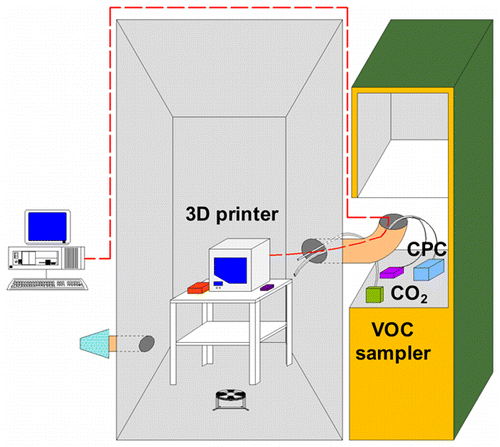 Since a recent study came out from researchers at the University of Texas at Austin, there’s been quite the conversation regarding 3D printing and safety in terms of fumes. While it seems like a common sense concern to arise if you are near a machine working away, melting plastic and such, some seem surprised at the thought of toxins—as if 3D printers are working under a magical cloud of innovation which simply could not be tarnished with something as common—and odious—as health hazards.
Since a recent study came out from researchers at the University of Texas at Austin, there’s been quite the conversation regarding 3D printing and safety in terms of fumes. While it seems like a common sense concern to arise if you are near a machine working away, melting plastic and such, some seem surprised at the thought of toxins—as if 3D printers are working under a magical cloud of innovation which simply could not be tarnished with something as common—and odious—as health hazards.
As I was having dinner with one of my friends a couple of nights ago who is actually very technologically savvy, I mentioned that I’d spent my afternoon reading a recent study, and exploring the hazards of 3D printing fumes and exposure to ultra-fine particles. I was pretty shocked as she scrunched up her nose in confusion, and asked, “Oh, do they really make fumes? What?”
As she continued to crunch on her salad, I had to consider the fact that some people might not think about things like that—or worry, regardless. Apparently MakerBot is concerned that a lot of people might be thinking and worrying about this, however, and it’s cause enough for them to put out information regarding the safety of their own products. I might note here, however, that the article, ‘Emissions of Ultrafine Particles and Volatile Organic Compounds from Commercially Available Desktop Three-Dimensional Printers with Multiple Filaments, does state that emissions are not better or worse depending on specific printers. What they do recommend however—and this is where MakerBot is right on target—is that manufacturers “work toward designing low-emitting filament materials and/or printing technologies” as well as working “to evaluate the effectiveness of sealed enclosures on both UFP and VOC emissions or to introduce combined gas and particle filtration systems.”
In their recent press release, MakerBot makes it clear that safety of their users is tantamount, and that they have it all covered. No worries here.
“A recent study has sought to answer safety-related questions regarding 3D printing filament,” MakerBot notes. “As supported by this study, we would like to underscore that our latest generation of 3D printers only use filament that is safe for your classroom or business. Known as PLA, or polylactic acid, this filament is a nontoxic resin made of sugar derived from starches found in foods, like potatoes, corn, grain, or even beets.”
This is important to point out actually, because if there were any questions—and if anyone really does read the study—it’s plain that the researchers did not find much concern with PLA, if any. The real concern—and again, if any—would be with ABS, as it emits styrene (a known carcinogen) in fairly large amounts. The researchers also stated that Caprolactam (known to be questionable) is found in fumes via nylon, PCTPE, laybrick, and laywood.
MakerBot really does seem to have all the bases covered on this one, as their recent 3D printers are all optimized to use MakerBot PLA Filament. They’ve made it clear that environmental concerns are at the top of their list, and especially with the accelerated growth of 3D printing in general. The team chose PLA as the material of choice for their recent product lineup because it is able to be composted and recycled.
 Through their collaboration with several national labs, MakerBot is also able make sure that their materials are up to par with all the latest requirements:
Through their collaboration with several national labs, MakerBot is also able make sure that their materials are up to par with all the latest requirements:
“… you will find our MakerBot PLA Filament is both compliant with regulations set by the Occupational Safety and Health Administration in the U.S. (OSHA) and the European Registration, Evaluation, Authorization and Restriction of Chemicals (REACH). For many countries, we offer Safety Data Sheets…”
MakerBot does make an interesting point regarding OSHA of course, in that with 3D printing still being such a fledgling industry, they are not really ‘geared’ toward emissions for this newer technology that’s generally performed on a smaller scale. Further studies are being done in terms of setting standards, according to MakerBot, as Underwriters Laboratories is working with two universities as they study whether or not safety requirements should be tightened up for 3D printing in regards to emissions.
“As standards evolve, we will continue to make sure every classroom, business, or home is as safe as possible with a MakerBot 3D Printer,” says the MakerBot team.
The bottom line overall would seem that as for many things in life, moderation is key when it comes to the amount of time you spend standing next to the 3D printer—although with PLA it would not seem that you have any concern. When printing with other filaments, ventilation is important. And all seem to agree that more studies are required on this subject. So for now, let’s all stop worrying—and get back to the wonderful world of creating. What type of filament are you printing with? Discuss in the MakerBot 3D Printing Filament forum over at 3DPB.com.
Subscribe to Our Email Newsletter
Stay up-to-date on all the latest news from the 3D printing industry and receive information and offers from third party vendors.
You May Also Like
Precision at the Microscale: UK Researchers Advance Medical Devices with BMF’s 3D Printing Tech
University of Nottingham researchers are using Boston Micro Fabrication‘s (BMF) 3D printing technology to develop medical devices that improve compatibility with human tissue. Funded by a UK grant, this project...
3D Printing Webinar and Event Roundup: April 21, 2024
It’s another busy week of webinars and events, starting with Hannover Messe in Germany and continuing with Metalcasting Congress, Chinaplas, TechBlick’s Innovation Festival, and more. Stratasys continues its advanced training...
3D Printing Webinar and Event Roundup: March 17, 2024
It’s another busy week of webinars and events, including SALMED 2024 and AM Forum in Berlin. Stratasys continues its in-person training and is offering two webinars, ASTM is holding a...
3D Printed Micro Antenna is 15% Smaller and 6X Lighter
Horizon Microtechnologies has achieved success in creating a high-frequency D-Band horn antenna through micro 3D printing. However, this achievement did not rely solely on 3D printing; it involved a combination...






























